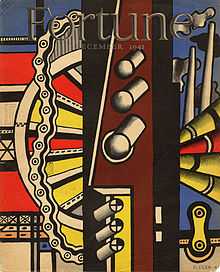Fortune (magazine)
 The April 30, 2007 issue of Fortune, featuring its Fortune 500 list | |
| Managing Editor | Andy Serwer |
|---|---|
| Categories | Business Magazines |
| Frequency | Monthly |
| Publisher | Time, Inc., a Time Warner company. |
| Total circulation (June 2012) | 846,965[1] |
| First issue | 1930 |
| Country | USA |
| Language | English |
| Website | www.fortune.com |
| ISSN | 0015-8259 |
Fortune is a global business magazine published by Time Inc. and founded by Henry Luce in 1930. The publishing business, consisting of Time, Life, Fortune, and Sports Illustrated, grew to become Time Warner. In turn, AOL grew as it acquired Time Warner in 2000 when Time Warner was the world's largest media conglomerate.[2] Fortune's primary competitors in the national business magazine category are Forbes, which is also published bi-weekly, and Bloomberg Businessweek. The magazine is especially known for its annual features ranking companies by revenue. CNNMoney.com is the online home of Fortune, in addition to Money.
History and organization
Fortune was founded by Time co-founder Henry Luce in February 1930, four months after the Wall Street Crash of 1929 that marked the onset of the Great Depression. Briton Hadden, Luce's partner, wasn't enthusiastic about the idea—which Luce originally thought to title Power—but Luce went forward with it after Hadden's February 27, 1929 death (probably of septicemia).[3]
Luce wrote a memo to the Time, Inc. board in November 1929: "We will not be over-optimistic. We will recognize that this business slump may last as long as an entire year."[4]

Single copies of that first issue cost $1 at a time when the Sunday New York Times was only 5¢.[4] At a time when business publications were little more than numbers and statistics printed in black and white, Fortune was an oversized 11"×14", using creamy heavy paper, and art on a cover printed by a special process.[5] Fortune was also noted for its photography, featuring the work of Margaret Bourke-White and others. Walker Evans served as its photography editor from 1945–1965.
An urban legend says that art director T. M. Clelland mocked up the cover of the first issue with the $1 price because nobody had yet decided how much to charge; the magazine was printed before anyone realized it, and when people saw it for sale, they thought that the magazine must really have worthwhile content. In fact, there were 30,000 subscribers who had already signed up to receive that initial 184-page issue.[5]
During the Great Depression, Fortune developed a reputation for its social conscience, for Walker Evans and Margaret Bourke-White's color photographs, and for a team of writers including James Agee, Archibald MacLeish, John Kenneth Galbraith, and Alfred Kazin, hired specifically for their writing abilities.
Fortune became an important leg of Luce's Time/Life media empire, which has grown to become Time Warner. For many years Fortune was published as a monthly, but, beginning in January 1978, twice a month. It considers its purview the entire field of business, including the people, trends, companies, and ideas that characterize modern business.
Marshall Loeb was named managing editor in 1986 and stepped down in May 1994 upon hitting Time Inc.'s mandatory retirement age of 65, to be replaced by Walter Kiechel III, an executive editor at the publication. During his tenure at Fortune, Loeb was credited with expanding the traditional focus on business and the economy with added graphs, charts and tables, as well as the addition of articles on topics such as executive life, and social issues connected to the world of business, such as the effectiveness of public schools and on homelessness.[6]
While circulation of the business magazines sector has apparently slumped since 2000,[7] Fortune claims their circulation has risen from 833,000[8] to 857,000[9] in that period.
In October 2009, as a result of declining ad revenue and circulation, Fortune began publishing tri-weekly rather than bi-weekly.[10][11]
Fortune lists
A theme of Fortune is its regular publishing of researched and ranked lists. In the human resources field, for example, their Best Companies to Work For list is an industry benchmark [citation needed]. Its most famous lists rank companies by gross revenue and profile their businesses:
- Fortune 500
- Fortune 1000
- Fortune Global 500
- Fortune India 500
- 40 under 40 (Fortune Magazine)
- Fortune Most Powerful Women Entrepreneurs
See also
References
- ↑ "eCirc for Consumer Magazines". Alliance for Audited Media. June 30, 2012. Retrieved December 2, 2012.
- ↑ "AOL Eats Time Warner". Retrieved 26 September 2010.
- ↑ Henry Luce & His Time by Joseph Epstein, Commentary, Vol. 44, No. 5, November 1967
- ↑ 4.0 4.1 Okrent, Daniel (September 19, 2005). "How the world really works". Fortune magazine.
- ↑ 5.0 5.1 Background
- ↑ Deirdre, Carmody (May 2, 1994). "The Media Business; A Shaper of Magazines Retires". The New York Times. Retrieved February 10, 2009.
- ↑ "Magazine audience". Project for Excellence in Journalism.
- ↑ "Circulation trends". magazine.org.
- ↑ "Fortune media kit".
- ↑ RICHARD PÉREZ-PEÑA (23 October 2009). "Fortune Magazine Will Drop From 25 to 18 Issues a Year". New York Times.
- ↑ Pérez-Peña, Richard (October 23, 2009). "Fortune media kit". The New York Times.
External links
- Official website
- List of 2008 100 Best Companies To Work For
- Complete Downloadable List of Fortune 500/1000 Companies – 1955–2008
- Fortune Magazine covers since 2004
- Fortune Magazine on Google+
- Fortune Magazine on Facebook
- @FortuneMagazine on Twitter